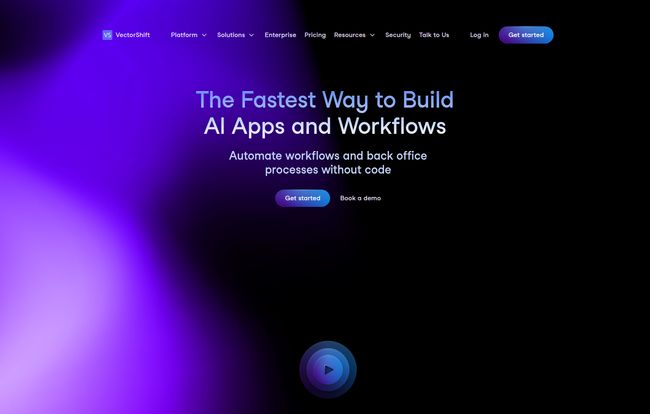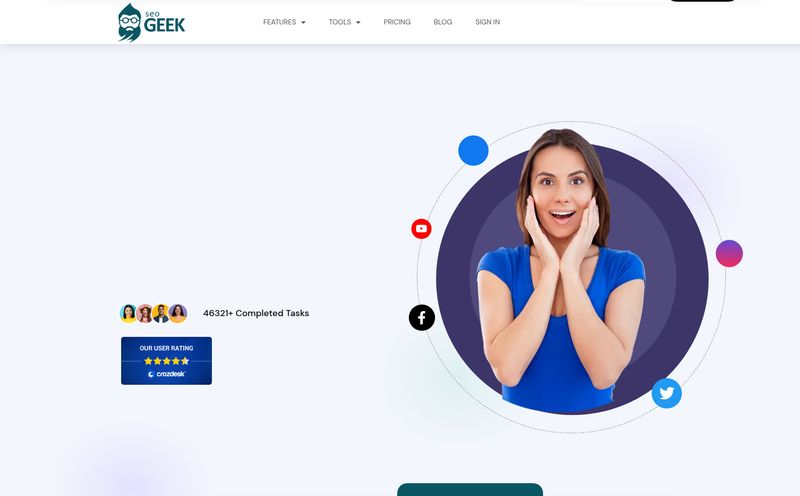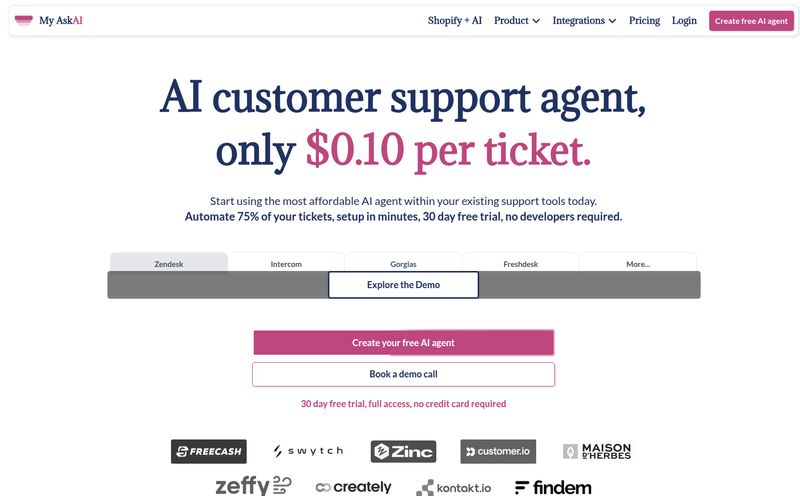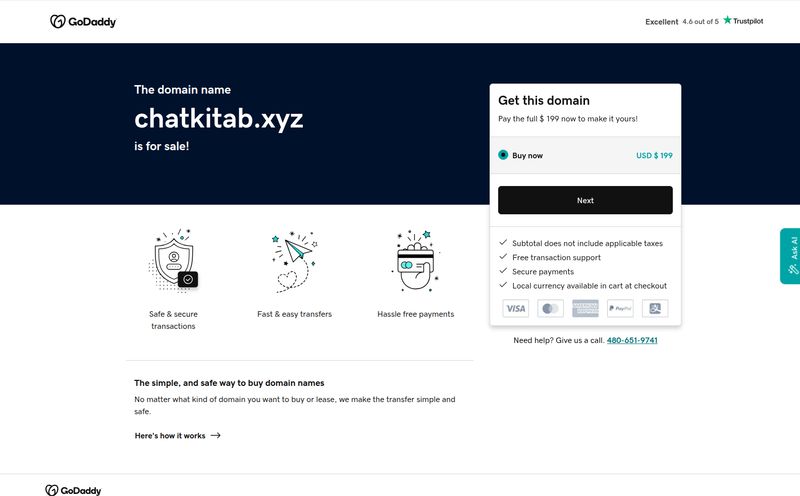The AI space is chaos. Glorious, exciting, world-changing chaos, but chaos nonetheless. Every single day there’s a new model, a new framework, a new “game-changing” tool that promises to make you a 10x developer or turn your small business into an automated empire overnight. It's a lot. And frankly, I’ve been getting a little tired of the hype.
For every genuinely useful innovation, there are a dozen half-baked apps that are more sizzle than steak. I've spent years in the trenches of SEO and traffic generation, and I've seen these hype cycles come and go. So when I first heard about VectorShift, a platform promising to let you build generative AI apps with a no-code interface, my professional skepticism kicked in. “Here we go again,” I thought.
But then I tried it. And I have to admit… I was wrong. This one feels different.
So, What Exactly Is VectorShift?
Imagine you have a brilliant idea for an AI tool. Maybe a chatbot that actually knows your company’s documentation inside and out. Or an app that automatically summarizes long, boring legal contracts into a few bullet points. A few years ago, you'd need a team of expensive developers and months of work. Today, you have platforms like VectorShift.
At its heart, VectorShift is a bridge. It’s a bridge between your brilliant idea and a functioning piece of software. It does this by offering two distinct paths, which is where the magic really lies:
- A No-Code, Drag-and-Drop Interface: This is for the visionaries, the marketers, the operations people—anyone who understands the problem they want to solve but doesn’t necessarily speak Python. It’s a visual canvas where you connect blocks to build out your AI workflow. It feels a lot like putting together a puzzle or building with Legos.
- A Full-Fledged Code SDK: This is the escape hatch. It's for the developers who start with the no-code builder but then say, “Okay, but I need to add this one very specific custom function.” Instead of hitting a wall, you can pop open the hood and write your own code, integrating it seamlessly with the rest of your visual workflow.
This dual approach is what sets it apart. It’s not just a simple no-code tool, and it’s not just a complex developer framework. It’s both, living together in harmony.

Visit VectorShift
The Things That Genuinely Impressed Me
I don't get excited easily. Too many tools over-promise and under-deliver. But as I spent more time with VectorShift, a few things really stood out.
The Visual Builder Doesn't Feel... Clunky
I’ve used my fair share of drag-and-drop builders, and many of them feel like they're held together with digital duct tape. They're slow, unintuitive, and you spend more time fighting the interface than building your idea. VectorShift is surprisingly smooth. Snapping together a pipeline—say, one that takes a user query, searches a knowledge base in your Google Drive, and then feeds it to an LLM for a natural language answer—is genuinely satisfying.
They have pre-built templates for common use cases like chatbots and document search, which are great starting points. You’re not staring at a blank canvas, you’re modifying something that already works. For someone just starting to build with AI, this lowers the barrier to entry from a massive wall to a small step.
A Universe of Connections
An AI tool is only as good as the data and models it can connect to. This is another area where VectorShift shines. Remember the great LLM wars of 2023-2024? It felt like every week there was a new 'GPT-killer'. Instead of forcing you to bet on one horse, VectorShift lets you tap into all the major players: OpenAI’s models, Anthropic’s Claude 3 family, Google’s Gemini, open-source heroes like LLaMA, and even models from AWS and Hugging Face. This is huge. It means you can swap models in and out of your workflow to see which one performs best for your specific task, without rebuilding everything from scratch.
And it’s not just LLMs. The list of integrations is solid, covering the tools where real work happens: Google Drive, Salesforce, HubSpot, Notion, Airtable, and so on. This is critical because it means you can build automations that pull from and push to the systems your team already uses every day.
The Big Question: VectorShift's Pricing
Alright, let’s talk money. For a while there, finding pricing info on their site was a bit of a treasure hunt, which is a pet peeve of mine. Thankfully, they've become much more transparent. And honestly, the structure is pretty compelling.
They have a few tiers, and the free one is actually useful—not just a frustrating teaser.
| Plan | Price (Billed Annually) | Best For | Key Features |
|---|---|---|---|
| Starter | $0 / month | Individuals & Hobbyists | 1 user, 1 pipeline, 1 chatbot, 2 knowledge bases, 20 runs/month. A genuinely free tier to learn and build. |
| Standard | $20 / user / month | Small Teams & Startups | More pipelines, more chatbots, more integrations, and a higher usage limit. This is the sweet spot for getting serious. |
| Pro | $100 / user / month | Scaling Businesses | Unlimited almost everything—pipelines, chatbots, integrations. Plus dedicated support via Slack. |
| Enterprise | Custom | Large Organizations | All the bells and whistles, plus advanced security, SSO, and custom solutions. |
My take? The Starter plan is more generous than it has any right to be. It’s perfect for tinkering with an idea without pulling out your credit card. The Standard plan is where a small business or a dedicated team would live, offering enough power to build and deploy real, valuable applications. The jump to Pro is for when your AI application becomes mission-critical.
Is It All Perfect? Of Course Not.
No tool is a silver bullet. While I'm pretty high on VectorShift, it’s not without its own set of considerations. The very feature that makes it so powerful—the Code SDK—means that to truly max out its potential, some technical chops are needed. If you want to do something wildly custom, you or someone on your team will need to be comfortable writing some code. That's not a con, per se, just a reality check.
Also, this isn't a magic wand. You can’t just connect a messy, disorganized folder of 10,000 random documents and expect it to create a perfectly omniscient chatbot. The old rule of “garbage in, garbage out” still applies. You need to have a clear strategy and clean data for the best results. VectorShift gives you the kitchen, but you still need to be a decent cook.
My Final Verdict: Who Should Use VectorShift?
So, is VectorShift worth your time? In my experience, absolutely yes—for the right person.
This platform is built for the AI Pragmatist. It's for the person, team, or business that has moved past the initial wide-eyed wonder of ChatGPT and is now asking, “Okay, but how do I put this to work for me?” It’s for the marketing manager who wants to build a personalized outreach sequencer, the operations lead who needs to automate report generation, and the startup founder who wants to prototype an AI feature fast.
It successfully walks the tightrope between being accessible to non-coders and powerful enough for developers. It's a fantastic middle ground that can take you from a simple prototype all the way to a sophisticated, production-ready application. It's less of a single tool and more of a full-on workshop. And right now, in this crazy, chaotic AI landscape, having a reliable workshop is an incredible advantage.
Frequently Asked Questions
Can I use my own LLM API key with VectorShift?
Yes, you can! This is a great feature. While they provide some free credits to get you started, you can plug in your own API keys from OpenAI, Anthropic, or other providers. This gives you full control over your usage and model access.
Is VectorShift for developers or business users?
Both, and that's the beauty of it. A business user can build entire workflows using the no-code interface. A developer can use that same interface for speed and then jump into the Code SDK for advanced, custom logic. It’s a collaborative platform where different skill sets can meet.
How secure is my data on the platform?
Based on their focus on Enterprise clients and integrations with tools like Salesforce, security is clearly a priority. They offer features like SSO and are likely compliant with major data protection standards. For highly sensitive data, you should always review their specific security documentation or talk to their sales team.
Can this really replace custom AI development?
For a huge number of use cases, yes. Building chatbots, internal search tools, document processing workflows—VectorShift can get you there faster and cheaper than starting from scratch. For something deeply novel or that requires a completely unique architecture, custom development might still be the path, but VectorShift could still be the best way to build your initial MVP.
What makes VectorShift different from something like Zapier?
That's a great question. Zapier is fantastic for simple, linear automations (IF this happens in App A, THEN do that in App B). VectorShift is designed for more complex, stateful, and AI-native workflows. It handles things like managing conversational history in a chatbot, performing vector searches on documents, and chaining multiple LLM calls together—stuff that's well beyond the scope of a typical Zapier workflow.



